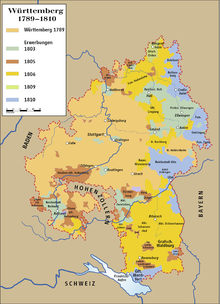Old Württemberg


As Altwürttemberg were referred from Reichsdeputationshauptschluss in 1803 the former dominion Württemberg unlike Neuwürttemberg in which the numerous territorial gains - have been combined - especially east and south Altwürttembergs.
Geographical structure
Old Württemberg was made up of those areas that had already belonged to the Duchy of Württemberg before 1803 : In addition to the former county of Württemberg in the core region on the Middle Neckar, these included the counties of Calw , Mömpelgard , Tübingen , Urach and Vaihingen , the lords of Heidenheim and Teck , the hereditary imperial fief of Grüningen as well as numerous smaller lordships and last but not least the many spiritual territories that the dukes Ulrich and Christoph had secularized and withdrawn in the course of the Reformation .
Independent islands in the Wuerttemberg territory were the imperial cities of Heilbronn , Esslingen am Neckar , Weil der Stadt , Reutlingen and the extensive Ulm on the south-eastern edge as well as some secular lordships whose locations are marked as red dots on Georg Gadner's map from 1596. Until 1803, Württemberg was one of the few Protestant territories that had a seat and vote in the Swabian Empire .
Political structure
Since 1477 there was already a university in Tübingen in Württemberg . Its founder, Count Eberhard im Bart , was made duke in 1495. After the uprising of poor Konrad , the Tübingen Treaty came into force in 1514 , which was to shape the constitution of Württemberg for centuries. Until 1805, the duchy had an assembly of estates characterized by the bourgeoisie and " prelates " , which restricted the rights and fiscal policy of the duke, but since the Reformation no longer had a nobility organized as a class because the formerly rural noble families had remained largely Catholic and submitted directly to the emperor and no longer saw themselves obliged to the Duke of Württemberg as a knight of the empire .
From 1803 until the final dissolution of the Holy Roman Empire of the German Nation in 1806, there was an independent state of Neuwuerttemberg for a short time with the seat of government in Ellwangen , in which the estates or the estates assembly of Altwuerttemberg had no say. Elector and Duke Friedrich I of Württemberg ruled both states in personal union until, thanks to Napoleon , he was able to consolidate them to form the Kingdom of Württemberg , thereby lifting the annoying constitution of old Württemberg "like a coup d'état". The political differentiation between Old Wuerttemberg and New Wuerttemberg was no longer applicable from now on, but was occasionally still used for regional delimitation.
In the 20th century, Altwürttemberg was the inspiration for the naming of the power supplier Kraftwerk Altwürttemberg AG (KAWAG) and the district building cooperative Altwürttemberg eG founded by Karl Joos . A horse breed that is now threatened with extinction was also called Altwürttemberger .
literature
- Walter Grube : Stands in Württemberg . In: From the assembly of estates to the democratic parliament . Theiss, Stuttgart 1982, pp. 31-50
- Wolfgang von Hippel: Economic and social history. In: Meinrad Schaab , Hansmartin Schwarzmaier (ed.) U. a .: Handbook of Baden-Württemberg History . Volume 3: From the end of the old empire to the end of the monarchies. Edited on behalf of the Commission for Historical Regional Studies in Baden-Württemberg . Klett-Cotta, Stuttgart 1992, ISBN 3-608-91467-6 , pp. 486, 519, 722.
- Bernhard Mann : Württemberg 1800 to 1866. In: Meinrad Schaab, Hansmartin Schwarzmaier (ed.) U. a .: Handbook of Baden-Württemberg History. Volume 3: From the end of the old empire to the end of the monarchies. Edited on behalf of the Commission for Historical Regional Studies in Baden-Württemberg. Klett-Cotta, Stuttgart 1992, ISBN 3-608-91467-6 , pp. 241 f., 246-251, 254-256, 265-266, 269-275, 287, 295, 330.
- Dieter Mertens : Württemberg. In: Meinrad Schaab, Hansmartin Schwarzmaier (ed.) U. a .: Handbook of Baden-Württemberg History. Volume 2: The Territories in the Old Kingdom. Edited on behalf of the Commission for Historical Regional Studies in Baden-Württemberg. Klett-Cotta, Stuttgart 1995, ISBN 3-608-91466-8 , pp. 1-163.
Individual evidence
- ^ Walter Grube : Stands in Württemberg . In: From the assembly of estates to the democratic parliament . Theiss, Stuttgart 1982, pp. 40ff
- ↑ Quotation from LeoBW : “In 1560 the knighthood in Swabia established an order that was confirmed by the emperor in the following year, but was only gradually accepted by all knights when it turned out that the large territories of Württemberg and Palatinate therefore did not give their vassals fiefs would withdraw. This was the last step to detach the knighthood from these two territories. "
- ^ Walter Grube: Stands in Württemberg . In: From the assembly of estates to the democratic parliament . Theiss, Stuttgart 1982, p. 49f.